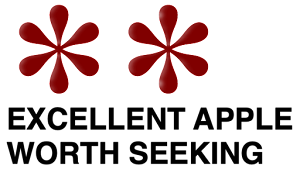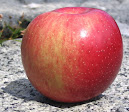 |
This rescued variety was once lost, and some mysteries remain.
Though appearance varies, these are mostly medium-large to large and moderately ribbed, with a beautiful orange-red blush over dull yellow (or on some, yellow-green).
On one smaller sample the blush is a more-saturated red and a cap of russet seems to spill over the blush side leaving big fat spatters on the blush.
Lenticels for the most part are small. They fade into the blush but are dark and easy to spot against the unblushed peel.
These all have a nice firm feel. There's no appreciable aroma. Crimson Gold has crisp light yellow flesh, coarse but quite firm and very juicy. The texture is very satisfying, breaking cleanly into gratifyingly crunchy chunks. Crimson is sweet tempered by considerable tartness. Flavors of cane sugar and orange juice come to the fore, and there are hints of cream soda and spice.
Crimson is sweet tempered by considerable tartness. Flavors of cane sugar and orange juice come to the fore, and there are hints of cream soda and spice.
A very fine apple when ripe (yellow, not green, beneath the blush).
The flavors in a less-ripe example were not as clear and assertive but seemed to include a whiff of flowers; the texture was still excellent.
Crimson Gold is one of the last rediscovered varieties created by California breeder Albert Etter, who also gave us the delectable Wickson Crabapple. Some authorities say that Etter originally called it "Little Rosybloom."
Beyond that, sources disagree.
Is Crimson Gold usually small due to crabapple bloodlines? (I would say, "Apparently not.") Or is it a Yellow Newton Pippin x Esopus Spitzenberg cross? (One source manages to say both.)
Some call this variety, bred in the 40s and almost lost on Etter's death, an heirloom; others tout its modern disease resistant characteristics.
Greenmantle Nursery, in Ettersburg California (Etter's home), tells how this variety was thought to be lost only to be rediscovered in the wintery ruins of the original orchard. (The story is towards the end of this web page.)
Greenmantle also says that the cutting thought to be Crimson Gold that was preserved at the U.S. Germplasm Repository at Geneva NY turned out to be Wickson. That might explain some of the above confusion, as Wickson is small and may be a crabapple hybrid.
Also according to Greenmantle: C Gold can survive lengthy boiling, one method used to ID this apple when rediscovered.
I recommend skipping that step and just eating them out of hand. They are really good.

I get confused because if you punch in crimson gold you get nurseries selling an apple tree called that with an r in between the two words. I had one sent to me by accident instead of a crimson crisp so they told me too keep it. I'ts from europe and a tart sweet apple. I'll be interested to see how it tastes.
ReplyDeleteI am similarly confused by the ® "registered" after the word "Crimson" on several web pages. How can you register the word "Crimson?" And what's with this European origin?
DeleteVolante Farm sold me my Crimson Golds and said that they were Etter apples. Hope your tree bears good fruit.
I had always assumed, based on the Greenmantle website story of the Germplasm Repository mistake, that the Cuyama Crimson Golds were actually Wicksons. Having never had a Wickson, I had nothing to compare to when I ate the Cuyama Crimson Golds. But they did look smaller than the Crimson Gold picture that Kuffel Creek has, and I think Kuffel Creek got their scion from Greenmantle.
ReplyDeleteKuffel Creek's description of the confusion around Wickson is the opposite of Greenmantle's, however, adding further to the confusion:
"The Crimson Gold orchards were under ownership of the California Nursery Company and somehow trees were being mislabeled, grown and distributed as Wickson apples (another crab apple variety). " (Kuffel Creek)
"CNC soon lost track of it - and the variety grown and distributed by the U.S. Germplasm Repository at Geneva NY under the name "Crimson Gold" turned out to be Wickson. After years of exploring the remnants of the Ettersburg test orchard, we had just about given up on ever finding this variety. " (Greenmantle)
Our local specialty produce appears to have copied and pasted the info from Kuffel Creek. And so confusion spreads on the internet....
Hi Mike. I've finally had both Wickson and also the confusingly tiny Crimson Golds from Cuyama. They are nothing alike.
DeleteI am not sure I follow you about Greenmantle versus Kuffle Creek. Might not both be accurate?
That is: Geneva got the wrong germ plasm, somehow, and so did the CNC.
Maybe these 2 errors even share a common origin.
Or am I missing something? They are not the same apple, I can tell you that.
Thanks for sharing about the Crimson Gold Apples. Hope you won't mind if I chime in here: I've tasted the crimson gold and have a Wickson apple tree and they are indeed different apples (texture, taste, etc.). I'm looking for a crimson gold apple tree to plant in our yard...would you know of any nurseries that offer it?
DeleteCristina, I wish I knew enough to be of help. This is a marvelous apple and more people should grow it.
DeleteYou might start with your state's agricultural extensions service.
Also, I know that Tougas Orchard here in Massachusetts grows Crimson Gold. If you are completely out of leads you could call them and ask who their source for budwood was. A local nursery could graft that for you.
Good luck with your tree! And don't forget to plant a suitable pollinating partner.
The following article is delightful and seems to comport with Adam;s opinion. "The Crimson Golds are at about 17 brix (a scientific measurement of sweetness) ..."
ReplyDeletehttp://www.shockinglydelicious.com/crimson-gold-apples-a-tiny-tasty-treat/
Although Wikipedia agrees with Adam, Cummins is saying CrimsonGold is a new apple; that's why the trade-mark.
Perhaps there are two different trees, same name.
@anon: The author writes winningly about crabapple-sized Crimson Golds from Cyuama Orchards in Southern California.
DeleteI bought a bag of these last January and marveled at their size, given that here in Massachusetts Tougas grows them to more-traditional heft.
I assume Tougas deliberately thins them out, defeating a natural tendency to be small. Or something like that.
Their are worth seeking out at whatever size.
Adam - The Crimson Gold apples sold by Tougas are the variety originating from the Czech Republic (not the Etter Crimson Gold). Also, the photo in this post does not appear similar the the Etter Crimson Gold that I grow.
Delete@Anon (other Anon?), that makes a lot of sense in light of the questions above!
DeleteIt does not help the confusion that the two varieties are, aside from size, a lot alike.
There is a Crimson Gold apple from the Czech Republic (first known as Svatava).
ReplyDeleteHow about that! What do you suppose they were thinking? They are not going to be able to keep a trademark on that.
Deletemost growers are now trademarking a name instead of doing a patent.This is because a patent only lasts for 18 or 20 years then it becomes public domain. Green Mantel Nursery has taken a lot of Albert Etter's creations and renamed them to trademark the variety. If you got a cutting and grafted a tree and called it little Rosybloom there is nothing they can do.
ReplyDeleteGreetings Adam. I have Wickson growing out now. And not only will have Little Rosybloom; but also Etter's applecrab that falls between Wickson and Crimson Gold/Little Rosybloom in size. Known as Vixen. I feel Etter recognized while Wickson has outstanding flavor; it's tender skin damaged even by rain would render it commercially useless. And Vixen and Little Rosybloom were attempts to correct the fragile skin issue. I will put some Vixen on P.2 rootstock and should have good crops in 2-3 years. I will be sure to send you some!
ReplyDeleteWell that sounds great, all the best for your trees!
Delete